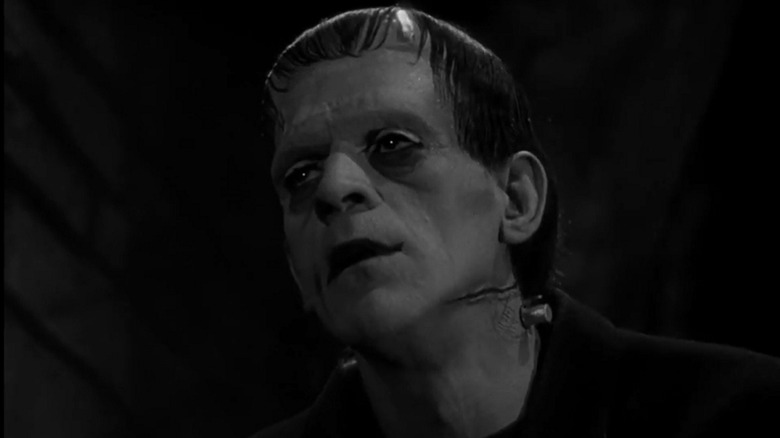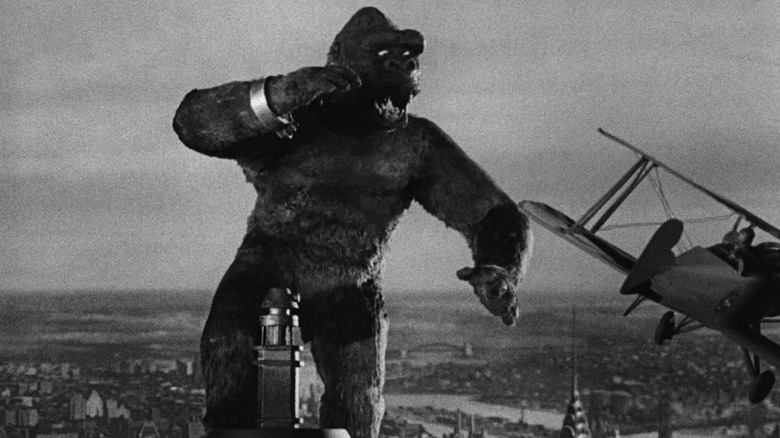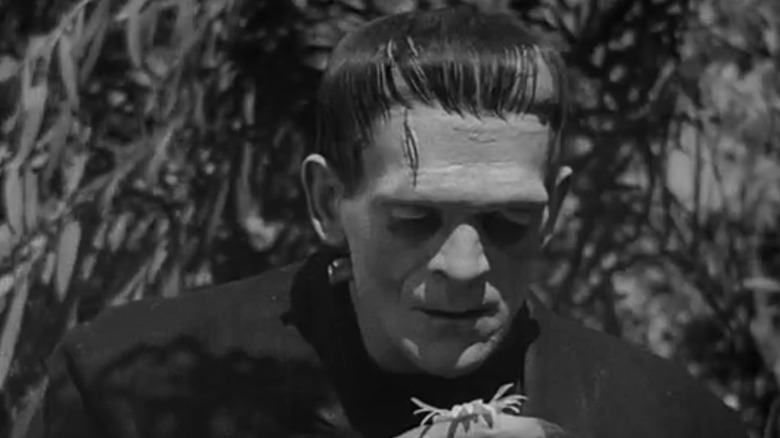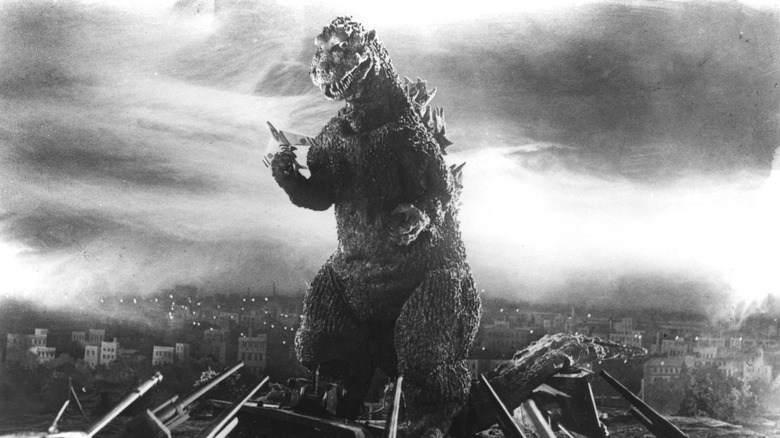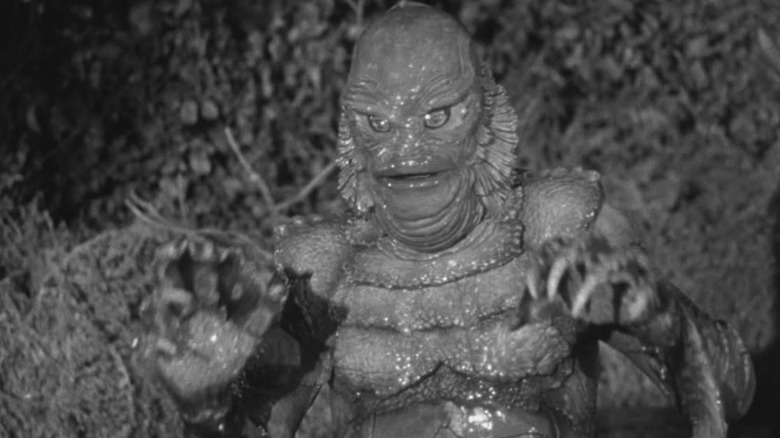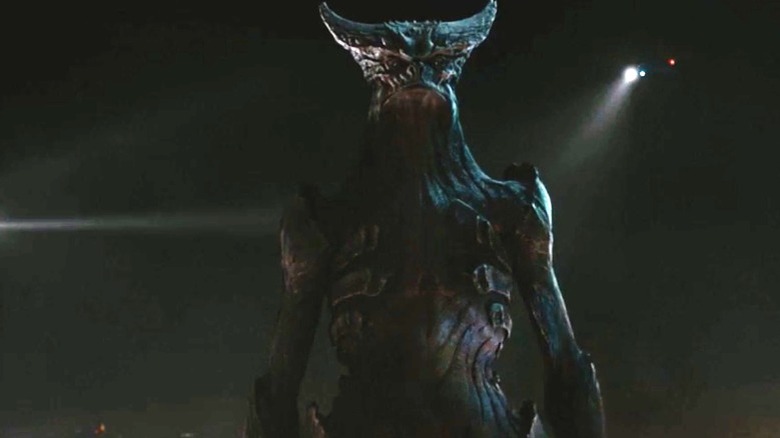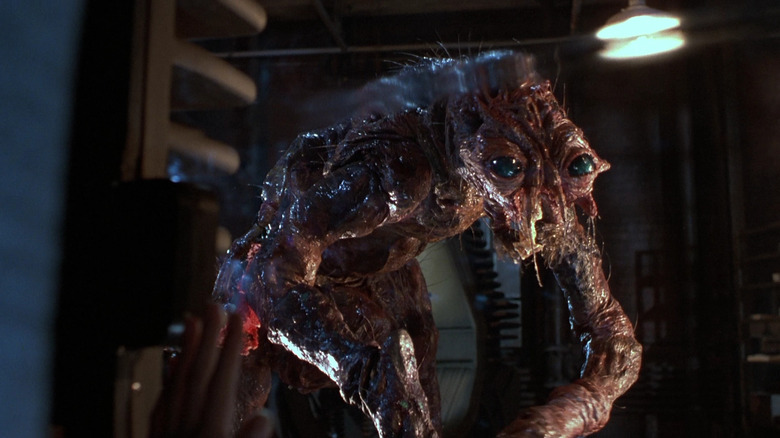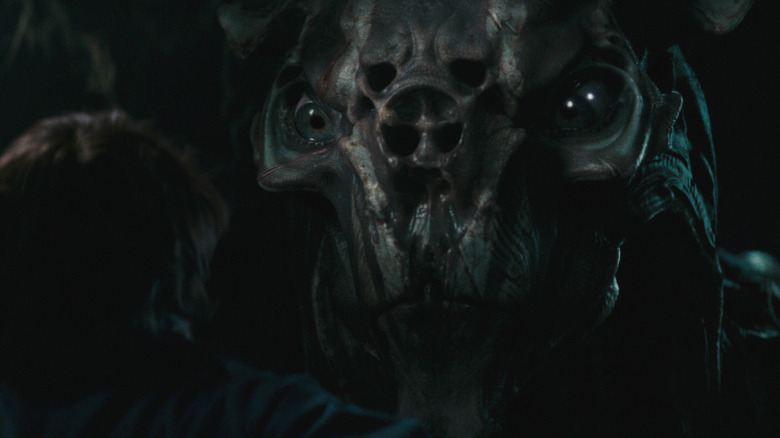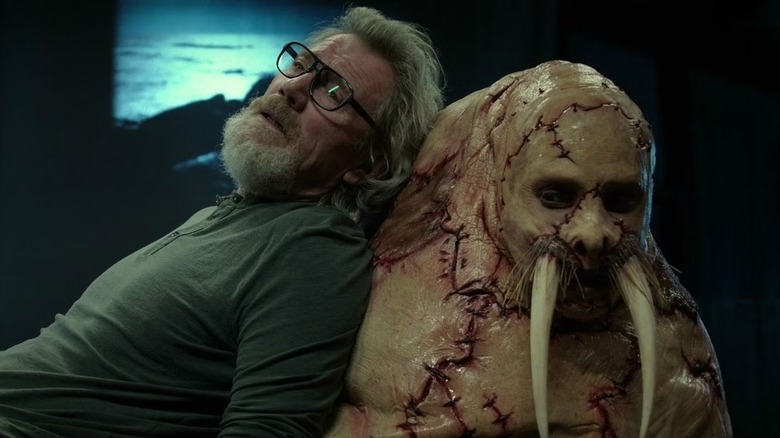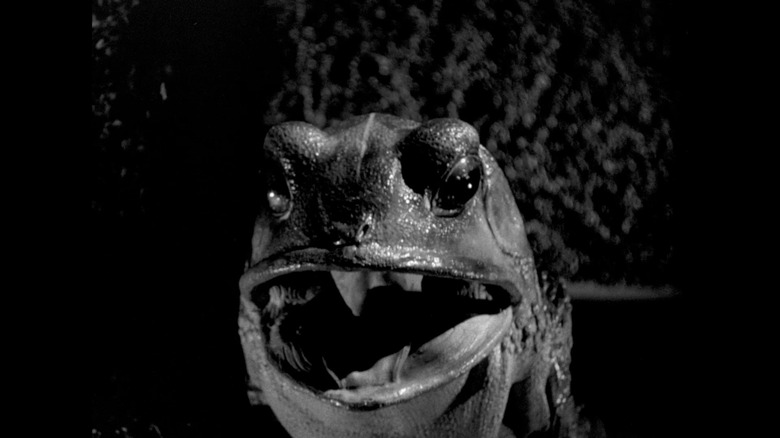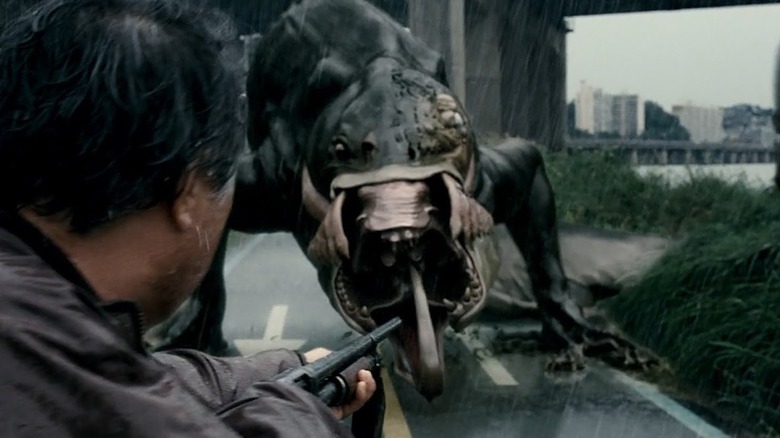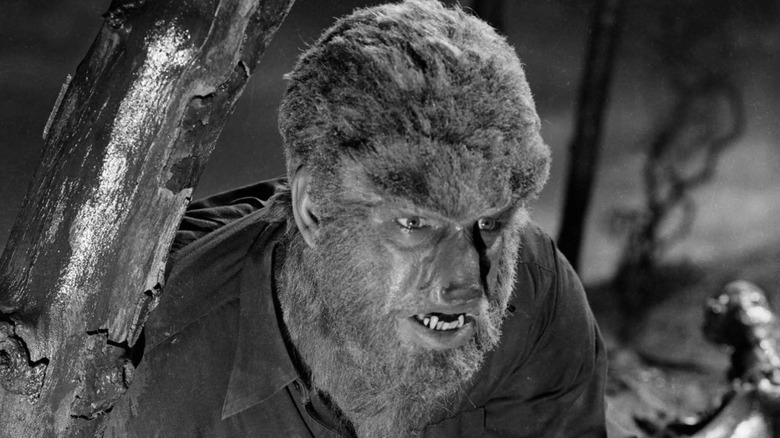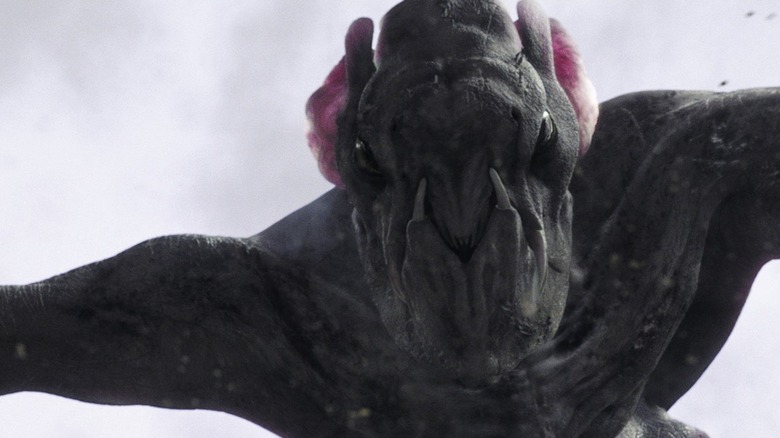Horror Movie Monsters We Actually Feel Sorry For
First and foremost, we think of movie monsters as things that scare us. These are the beasts that define what we find scary. Just look at how beaches were changed forever by the man-eating shark from "Jaws." Filmmakers such as Guillermo del Toro, James Whale, or J.J. Abrams have often been involved in movies that moved the needle on what horror movie monsters can be. Specifically, these artists have reconfigured the public image of monsters to be more sympathetic. These may be gigantic beasts or vicious organisms, but they're also creatures who convey something discernibly vulnerable or even relatable.
Examples of horror movie monsters that elicit sympathy from the audience can be found in many films throughout the history of scary cinema and include some of the most iconic movie monsters ever like Godzilla or King Kong. These creatures get moviegoers to feel sorry for them through details ranging from aspects of their design to their origins to even something as simple as their on-screen behavior. Whatever the reason, these horror movie monsters are great examples of creatures that tug at our heartstrings as easily as they make our pulse quicken.
King Kong
It's hard not to feel some level of sympathy for the 1933 version of King Kong. He's just a big monkey, a massive critter you want to give a pat on the head rather than flee from in terror. His sheer size in comparison to the human characters makes it believable that he'd be a threat to them simply by not looking where he's walking. Still, just by being a primate, Kong has an endearingly cuddly quality to him. His likeability becomes even more apparent once he climbs to the top of the Empire State Building.
Having ascended above all other New Yorkers with a lady (Faye Wray) in his hand, Kong seems like he may reign supreme. However, a sortie of airplanes begins shooting at this creature, making his doom certain. It's here that the most richly empathetic scene in "King Kong" occurs, as the audience witnesses this ape slowly realize that he's not getting out of this scenario alive. Kong's gestures and resigned body language convey this animal gradually coming to terms with his fate. It's in this moment that we realize that Kong is a tragic monster, an animal forced into a bustling city and then slaughtered for being frightened by his unfamiliar surroundings. This excellent piece of stop-motion animation cements Kong as one of the most sympathetic movie monsters in history.
Frankenstein's monster
The character that all other sympathetic horror movie monsters are modeled after, Frankenstein's monster as portrayed by Boris Karloff, makes your heart ache more than he makes you scream. Under the direction of James Whale, this creature is depicted as a being thrust into a world he can't comprehend and villainized for just not understanding how conventional society operates. His creator has cursed this Universal Monsters icon with an existence defined by ostracization and insecurity.
The sympathetic qualities of Frankenstein's monster become even more apparent in "Bride of Frankenstein," the second appearance of this iteration of the character. Here, the cruelty of the local townspeople is especially apparent, particularly in a sequence depicting these folks disrupting a friendship between the creature and an old blind man. The overwhelming loneliness of Frankenstein's monster leads him to demand his creator make him a companion, but even the titular bride cannot stand this monster. Loneliness and repulsion follow the creature wherever he goes. The powerful tragedy defining this interpretation of "Frankenstein" remains influential to this day for a reason.
Godzilla
Most popular versions of Godzilla have been made loveable for general audiences. Even the incarnation seen in the 21st-century MonsterVerse is painted as a heroic figure, even if he's guilty of kicking King Kong around. The 1954 iteration of Godzilla is much darker than later installments in the franchise like "Son of Godzilla," but it still presents the big lizard as a sympathetic character. Chiefly, the creature's existence hinges on man's obsession with nuclear weaponry. A metaphor for the use of the atomic bomb on the Japanese populace by American forces in World War II, Godzilla's very presence is a warning against the use of nuclear arms.
"Godzilla" doesn't just provide a parable for the dangers of nuclear warfare, it also instills a sense of tragedy in Godzilla even being around in the first place. He destroys everything in his path. There's no denying that, but he also never asked to exist in the first place. He's a byproduct of humanity's hubris, not a creature who seeks out our world and decides to tear it to shreds. Of course, the design and black and white cinematography of "Godzilla" still make this one of the most intimidating visions of the beast. However, there are still plenty of elements to ensure audiences are at least somewhat sympathetic to Godzilla's plight.
Creature From the Black Lagoon
Some monsters want to ward away humans from a great treasure or item they're guarding. Others are just hungry and looking to chow down on people. Then, there's the Creature from the Black Lagoon. This member of the Universal Monsters lineup, referred to as "Gill-Man," is driven by romantic yearning rather than just a hunger for bloodthirsty violence. Specifically, Gill-Man is enamored with Kay Lawrence (Julia Adams). This infatuation becomes so intense that the climax of "The Creature from the Black Lagoon" revolves around Gill-Man kidnapping Lawrence and taking her to his domicile.
Romantic infatuation does not justify kidnapping ladies, but the motivation for Gill-Man's behavior is thoroughly unique among movie monsters. Gill-Man is made even more sympathetic because Lawrence and the other members of the expedition she's traveling with choose to intrude on this beast's territory. Gill-Man is initially just curious before becoming frightened by these newcomers in his midst. This isn't a monster that goes out of his way to kill people, he's just responding to the interlopers who are invading his territory. Though he may not resemble any conventional human being, Gill-Man's exploits in "Creature from the Black Lagoon" are grounded in human desires.
Gloria's monster from Colossal
Big horror movie monsters capable of destroying cities are often more sympathetic than they appear. Godzilla, Mothra, Clover, and so many other beasts just look like rampaging monsters on the outside, but they're usually more complicated and technically less "monstrous" than human antagonists. This trend was reinterpreted in fascinating detail with "Colossal," which presents viewers and the film's protagonist, Gloria (Anne Hathaway), with the incredible sight of a monster attacking Seoul.
The audience soon understands the nuances of this monster, though this depth is revealed in a unique way. Rather than the monster being misunderstood, writer-director Nacho Vigalondo reveals that the monster is actually a being that Hathaway unconsciously controls while she's wandering around in a playground. The beast is a physical manifestation of how Gloria's actions affect others without her realizing it — a wake-up call for the ripple effects of her behavior. The sympathetic nature of the monster in "Colossal" comes from seeing it as an allegory for parts of Gloria. Her relatable flaws are given a fleshy vessel within this Godzilla-esque creation. "Colossal" is a unique twist on the idea that monsters can be more human than even the human characters in a creature feature.
Seth Brundle from The Fly
Seth Brundle (Jeff Goldblum), the protagonist of David Cronenberg's "The Fly," has a relatively normal life at the film's start. He' has a steady job, a burgeoning romance with a journalist named Veronica "Ronnie" Quaife (Geena Davis), and ambitions of changing the world with the teleportation pods that he's developed. While testing out those pods, he discovers something has gone awry. A fly has made its way into the teleporter. Soon, he finds himself transforming into a human-fly hybrid. As his body deteriorates, he slowly becomes a massive human-sized insect devoid of the humanity that made Brundle so endearing at the outset of the film.
It's impossible to watch "The Fly" and not get wrapped up in this monstrous beast's plight, especially since Brundle's transformation into the titular creature is entirely incidental. It's a fluke that a fly got into those teleportation pods and set Brundle down the path to being a monster. Plus, Brundle's resistance to what he's becoming, including his final plea of "kill me" to his lover, only heightens the sense of tragedy surrounding his experience. The monster in "The Fly" is terrifying, but that horror never comes at the expense of the sympathy we have for Brundle.
Cooper from Super 8
In "Super 8," an everyday American town is thrown into chaos by the unexpected release of an alien creature. Referred to as "Cooper," it functions much like the shark in "Jaws" as a largely unseen creature that grabs unsuspecting people and pulls them away to certain doom. Initially, Cooper doesn't seem to have any sympathetic qualities and instead comes across as a monster you can hate without hesitation.
As the story goes on, the adolescent protagonists discover that there's more going on with Cooper than they realize. Through secret research footage, these characters discover that Cooper has been held captive and tormented by U.S. government agents for years, which has left Cooper with long pent-up anger towards humanity. Cooper emerges as a figure responding to trauma rather than a mindless killing machine. This becomes apparent in the third act when the lead character of "Super 8," Joe Lamb (Joel Courtney), speaks to Cooper about how you don't have to give in to anger after horrible events, paralleling his struggle to move forward after his mom's death. Making such an explicit connection between Cooper and the protagonist of "Super 8" makes it apparent that the audience is meant to sympathize with rather than be merely terrified of this monster.
Wallace's walrus form in Tusk
Podcaster Wallace Bryton (Justin Long) is not a monster at the beginning of "Tusk." However, his quest to interview oddball Canadian local Howard Howe (Michael Parks) ends up turning him into one, as Wallace is gradually transformed into a walrus. Trapped inside Howard's home, Wallace is torn apart and then put back together again by this demented and disturbed human being. This body horror tale eventually leaves Wallace unable to speak, only able to communicate through muffled screams and roars akin to the noises real walruses make.
The climax of "Tusk" sees Wallace becoming especially monstrous in a duel with Howard, the latter decked out in his own walrus costume. This fight results in Wallace killing Howard, impaling him with one of his tusks and reveling in his victory in a grisly fashion. It's clear through this instance of decidedly pronounced violence that Wallace has become a monster unlike any other in horror film history. However, his unwilling transformation into such a creature makes him a tragic and sympathetic figure, particularly in an epilogue that hints that Wallace retains some hint of humanity. Wallace fits right in with the long history of movie monsters that break our hearts.
Sir Roger McTeam from The Maze
The 1953 mystery movie "The Maze" ends with a terrifying reveal of who's been running the mansion that the main characters have been staying in. This domicile belongs to Sir Roger McTeam, who is a human-sized frog. The beast chases the protagonists across the estate, roaring menacingly. His rampage comes to an end when he flings himself out of a top-story window. Once he's dead, it's explained that McTeam was a man who, while in the womb, never evolved into a human being. Hence, McTeam was doomed to look like a massive amphibian while possessing the intellect of a human and cognizance of his situation.
The ending of "The Maze" is bonkers. It's the kind of twist ending that could've only existed in 1950s B-movie horror cinema. Given how he's practically pushed up the stairs by supporting characters in his climactic rampage, McTeam isn't exactly terrifying. However, he very much qualifies as a horror movie monster, and you can't help but feel a twinge of sympathy for him. Besides, you probably wouldn't be in the best of moods if you were doomed to live out your days as an abnormally large frog.
Gwoemul from The Host
Given Bong Joon-ho's love for subversive genre entertainment, it shouldn't be a surprise that his monster movie, "The Host," is much more than a "Godzilla" knock-off. In "The Host," the monster emerging from the sea to cause chaos is Gwoemul, which initially appears to be the primary adversary of the feature. However, as teased in a prologue, this creature exists only because of the negligence of the American and South Korean militaries.
As the film goes on, government forces become even more adversarial, falsely announcing that the Gwoemul is carrying a virus in a bid to control the population. By the end of "The Host," the government is even willing to use a toxin called Agent Yellow to subdue the beast – regardless of how it will affect the general population. Gwoemul is eating people, so it's not like this monster is devoid of menace. However, he wouldn't even be around to terrorize people if it weren't for the actions of powerful people who are often the greatest enemy in "The Host."
The Wolf Man
The Universal Monsters get much of their iconic stature from running with the idea that strange-looking beasts can have feelings. The titular monster of "The Wolf Man" is no exception. Much of the sympathetic nature of this particular creature comes from his origins. While out with his romantic crush Gwen (Evelyn Ankers), Larry Talbot hears Gwen's friend, Jenny (Fay Helm) in trouble and races to save her. The young lady is being attacked by a wolf. Larry promptly kills the animal with an ornate walking stick topped with a silver wolf's head but not before the beast, that he later discovers is a werewolf, bites him on the chest. With this chomp, Larry is cursed to be the Wolf Man.
Larry's forced existence as a violent creature of the full moon is not the result of hubris or an ironic punishment for a behavior defect but rather the result of him trying to help another human being. This tragic detail lends an instantly sympathetic quality to his existence as the Wolf Man. The viewer's heart aches even more for this guy by the time the third act arrives. Larry tries to leave town to minimize any potential carnage he can wreak only for his father to step in and tie him down (literally) to his current home. Larry didn't choose to be the Wolf Man, and he tries to minimize the beast's fury when he can. Those are actions that define the enduringly interesting and sympathetic qualities of a great Universal Monster.
Clover from Cloverfield
In "Cloverfield," audiences never get much insight into the mindset of the monster that's tearing up New York City. After all, the protagonists are everyday people who capture the events of the film on a camcorder by happenstance. It wouldn't make sense for them (or the viewer) to know too much about the creature that's reducing everything around them to rubble.
However, the artists behind "Cloverfield" had a very concrete backstory concocted for this being they dubbed "Clover." Talking to Animation World Network, creature designer Neville Page noted that Clover is a baby of its species. Awakened and separated from its parents and normal habitat, the monster is terrified of all the unknown things around it. Clover proceeds to smash up New York in a horrified frenzy. There is no malice towards the human race or a complicated evil plot at work here – just primal fear. Of course, incorporating this detail didn't mean skimping on Clover's terrifying nature. This monster still causes untold amounts of collateral damage. However, this unspoken backstory lends more than a hint of tragedy to this creature, making Clover arguably more sympathetic than the oftentimes uncouth human leads of the film.
